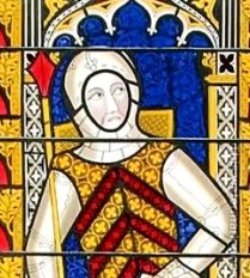
Gilbert de Clare, 6th Earl of Hertford; 7th Earl of Gloucester
Born: September 2, 1243
Christchurch, Hampshire, England
Died: December 7, 1295
Monmouth, Monmouthshire, Wales (Age 52)
Gloucester in History
Not much is known about the early life and upbringing of Gilbert de Clare, but his family had long been members of the English nobility and his father, Richard, was a powerful lord within the government of King Henry III and had been a leading figure in the ratifying of the provisions of Oxford (1258, a series of documents that continued upon the ideas of the Magna Carta, giving more control to the council and limiting the king's power). Gilbert began his adult life right around the time that the Second Baron's War, led by the king's brother-in-law Simon de Montfort, began to take shape. When Gilbert's father died (1263), Gilbert became Earl of Hertford and Gloucester but was angry when the king seized his lands (since he was technically still underage) and granted a huge dowry to the widowed countess, Gilbert's mother. It is for this reason that the new earl joined forces with Montfort against the king. The rebels defeated the royal forces at Lewes, and both the king and Prince Edward, his eldest son and heir, were taken captive, leaving Montfort in charge of the country's government. However, Gloucester became disillusioned with the way Montfort ran the country (and the fact that his sons were receiving most of the royal patronage available) and decided to rejoin the royal faction, attempting to rescue the king and allowing Prince Edward to escape captivity. Gloucester joined forces with the prince and several others to do battle against Montfort at Evesham, where they decisively defeated the rebels, with Montfort himself being killed.
After Montfort's defeat, Gloucester was pardoned for all his earlier offenses but was still unhappy that his mother had such a large dowry, taking away from his own wealth, and that he had not been properly rewarded for his participation at the Battle of Evesham. Therefore, Gloucester was, once again, in open rebellion against Henry III, taking control of London and championing a group of disgruntled noblemen known as the disinherited (since they had lost their ancestral lands for participating in Montfort's rebellion). Luckily, the two sides were quickly able to reach an agreement, and the Second Baron's War officially came to an end with no bloodshed. The earl was again returned to royal favor, and it was agreed that he would accompany Prince Edward to the Holy Land (this never actually happened). However, Henry III angered Gloucester, yet again, by agreeing to a treaty with Prince Llywelyn of Wales which would have been detrimental to the earl's Welsh interests. An agreement was ultimately agreed upon, and after Prince Edward left on crusade (1270), Gloucester remained faithful to the old king until his death in 1272. Since the new King Edward I did not return from the Holy Land until 1274, Gloucester and other lords ran the government in his absence
When the king returned, Gloucester undoubtedly faced a stronger monarch than he did in Henry III and was very much kept in check. The earl though, was a valuable ally to Edward I, who was dealing with increasing problems from Llywelyn in Wales, where Gloucester had considerable influence. By 1282, Llywelyn had been killed in battle, his brother Dafydd captured and executed the following year, and Wales was effectively annexed by England. In 1290, Gloucester became a part of the royal family when he married the king's daughter Joan, who was nearly thirty years his junior (he had already ended the marriage to his first wife). Despite the large age gap, the marriage proved to be a fairly happy one, producing a son and two daughters. The remainder of Gloucester's life was spent in conflict. First, he angered the king and was briefly imprisoned when he engaged in a feud with the Earl of Derby. Finally, the earl faced further revolts in his Welsh territories, forcing him and his family to flee Wales. Gloucester's Welsh territories were finally returned to him in October 1395, two short months before his death at the age of fifty-two. Gilbert de Clare, whatever one may think of his general personality, must be looked at as a strong man and a survivor. He continuously switched sides in the Second Baron's War and defied the king on many occasions, still keeping his wealth - and his head. That is more that can be said for many others who dared defy a king.
Gloucester in Peele
Appears in: Edward I
The Earl of Gloucester appears in Edward I as a loyal servant to the king and is eventually married to his daughter Joan. Within the play, the marriage (which occurs in 1290 historically) happens before the deaths of Llywelyn and Dafydd (1282, 1283) and the coronation and deposition of John Balliol of Scotland (1292, 1296). Additionally, Gloucester outlives his wife Joan, who historically died in 1307, twelve years after the earl's death. These are some of the many historical inaccuracies within a play that is highly episodic.
References
Knowles, Clive H. ‘Clare, Gilbert de , seventh earl of Gloucester and sixth earl of Hertford (1243–1295)’, Oxford Dictionary of National Biography, Oxford University Press, 2004 [http://www.oxforddnb.com/view/article/5438, accessed 23 May 2010]